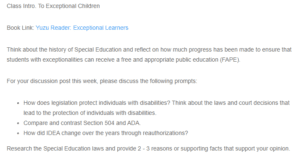Class Intro To Exceptional Children
Several federal laws and court decisions protect people with disabilities. Individuals with disabilities are protected under the Americans with Disabilities Act (ADA) from discrimination in work, housing, and public accommodations. The Rehabilitation Act of 1973, specifically Section 504, forbids disability prejudice in federally sponsored programs and activities (Evaluation Process / Laws That Govern Special Education). Individuals with Disabilities Education Act (IDEA) warrants that incapacitated kids must have access to free and fitting public education. Individuals with disabilities are also protected from housing discrimination under the Fair Housing Act. Furthermore, court decisions such as Olmsted v. L.C. and E.E. have established that people with disabilities have the right to live in the community and receive necessary support and services rather than being institutionalized.
The Americans with Disabilities Act (ADA) and Section 504 are both federal regulations that forbid discrimination of persons with disability. Section 504 applies to all federally sponsored programs and activities, whereas the ADA applies to employers, property owners, and public businesses. Section 504 focuses on ensuring disabled students’ access to education (Evaluation Process / Laws That Govern Special Education). In contrast, the ADA focuses on ensuring equal employment opportunities and access to public accommodations. Both laws require reasonable accommodations for people with disabilities. However, the ADA has stricter definitions of what constitutes a disability and requires employers to make accommodations unless it would cause undue hardship. The Departments of Education and Justice are in charge of enforcing both laws.
IDEA has had numerous reauthorizations since it was first passed in 1975. The Every Student Succeeds Act (ESSA), passed in 2015, was the most recent reauthorization of IDEA. The switch from a “compliance-based” to a “results-driven” approach, emphasizing accountability for student success, was one key improvement (Smith 37). Evidence-based practices and ensuring that kids with disabilities are included in the district- and state-wide accountability systems have also received more attention because of ESSA. Furthermore, ESSA offered states and districts more freedom in using IDEA monies while extending the definition of “highly qualified” teachers to include special education teachers. ESSA also underlined how crucial it is for all stakeholders to work together and engage parents in their children’s education.
Works Cited
“Evaluation Process / Laws That Govern Special Education.” Evaluation Process / Laws That Govern Special Education, https://www.ssdmo.org/step1/laws.html.
Smith, Tom EC. “IDEA 2004: Another round in the reauthorization process.” Remedial and Special Education 26.6 (2005).
ORDER A PLAGIARISM-FREE PAPER HERE
We’ll write everything from scratch
Question 
Book Link: Yuzu Reader: Exceptional Learners
Think about the history of Special Education and reflect on how much progress has been made to ensure that students with exceptionalities can receive a free and appropriate public education (FAPE).

Class Intro To Exceptional Children
For your discussion post this week, please discuss the following prompts:
- How does legislation protect individuals with disabilities? Think about the laws and court decisions that lead to the protection of individuals with disabilities.
- Compare and contrast Section 504 and ADA.
- How did IDEA change over the years through reauthorizations?
Research the Special Education laws and provide 2 – 3 reasons or supporting facts that support your opinion.
A good source for information on this topic is the U.S. Department of Education: U.S. Department of Special EducationLinks to an external site. Link: Every Student Succeeds Act (ESSA) | U.S. Department of Education
